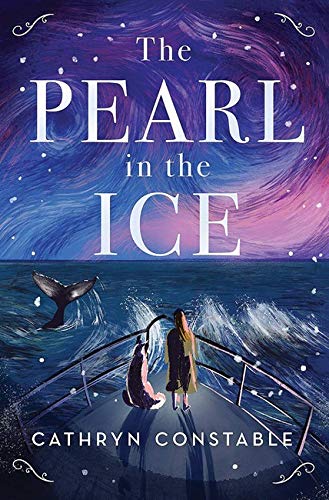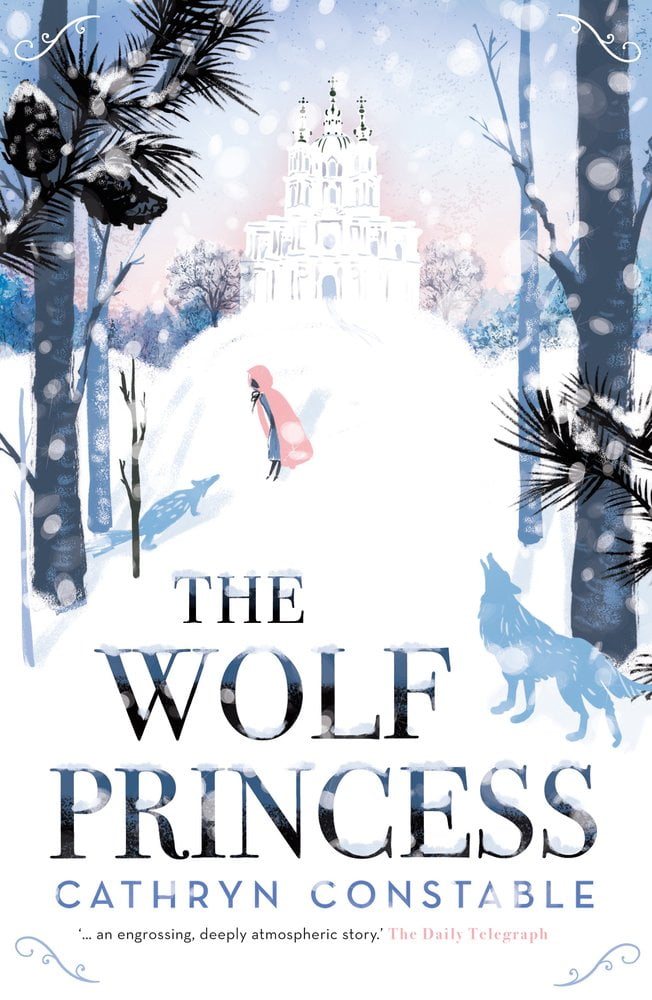Today we welcome Cathryn Constable into The Reading Realm to talk about her thrilling, atmospheric new children’s book THE PEARL IN THE ICE…
Marina’s father, a naval captain, has been away for most of her life – certainly since her mother died – and yet Marina feels the pull of an ocean she’s never known.
When sent to boarding school to learn to be a lady, Marina decides instead to stow away on her father’s ship. A perilous voyage awaits – but where are they sailing to and why, and what has it to do with the dark shape in the deep that seems to be following them?

Without giving too much away, can you tell us about your new book, The Pearl in the Ice?
It’s set in 1913 and tells the story of Marina Denham. She’s an only child, a naval commander’s daughter, whose mother disappeared when she was very young. She’s plucky and spirited. She doesn’t know what she wants to do with her life other than defy her father’s limited expectations for her. Rather than be sent away to some ghastly ladies’ college, she follows her father to the docks, meeting a mesmerizing woman, Miss Smith, on the train who fills her head with all sorts of ideas of how a woman might behave. Rather than return to London and ‘real life’, Marina stows away on her father’s boat. Of course, she can’t realise the dangerous nature of her father’s mission to the far northern seas… Or what it might mean for her. Or how the blurred memories of her absent mother might impact on reality.
How is The Pearl in the Ice similar to your other book, The Wolf Princess?
And of course, there was another book, The White Tower. All my books are about being on the brink in some way. I’ve always felt that being 11 or 12 is a really interesting time for a child or young person. It’s the first opportunity to begin to understand who you really are; you’re beginning to pull away from your family, form a peer group, explore the world. But you’re still very contained by that family group whilst having the ability to dream in a fluid and lucid way about the world and society and your place in it. It’s such a brief, passing moment in your development, but it’s like that moment between waking and sleeping. And as such, it’s endlessly fascinating. So I think I like to look at girls (all my novels have had a young girl as the central character, with attendant boys) and how that moment might be for them. How they begin to make sense of their family and their society. The Pearl in the Ice is less dreamy than The Wolf Princess… a bit more action, I think. And of course the setting is very different. A boat in the North Sea rather than a forgotten Winter Palace. But the concerns are the same.

Gender seems to be an important theme in The Pearl in the Ice – Marina is constantly told that she can’t do things because she is a girl and is in awe of Miss Smith’s style and lack of regard for rules. Why did you decide to tackle this issue?
I set the book just before the First World War because it seemed as if I could really highlight the lack of awareness of young women’s ambitions. I think that for a long time, many of us thought that these battles of education for women and equality in the work place were almost won. But now it feels as if we’ve not just taken a step back, but that we’re not even sure what equality looks like. But it was also important to highlight that it wasn’t great for a lot of men, either. They worked in coalmines. They were sent to the trenches. So I hope I’m able to be balanced and show that it wasn’t great for a good many people. But I believe that any society which finds a reason to deny women an education is entirely suspect. But girls might have to demand that they be educated. And mothers demand it for their children.
Parts of the story reminded me very much of Philip Pullman’s Northern Lights and even C S Lewis’s The Lion, the Witch and the Wardrobe. Are either of these stories favourites? What other books and authors would you save have influenced you?
The Chronicles of Narnia are astounding. Clear, lucid stories that never cease to amaze. I’m always drawn to stories that have an element of the ‘other’ in them, of stepping through into another realm. I think because of that sense of being aged ten or eleven and intuiting that there was ‘more’ to the world than could be merely seen or heard or touched. It’s just a fleeting sense that soon gets taken over by reality. But I love stories that are able to expand in that way. I think it’s why I don’t get on with Modernist writers particularly well. I know that language lies and is inherently unstable, but it’s just a veil. I like to have a glimpse behind that veil. Of course, Philip Pullman is extraordinary and I’m just grateful that those stories exist. Stories with layers that reveal even as they conceal. I also love Catherine Fisher and can’t understand why she isn’t on more reading lists, and isn’t being given all the prizes. I’ve always been a fan of Philip Reeve as well.
As a child, I LOVED mermaids! What research did you do regarding myths, the oceans, sailors and mermaids when writing this book?
What is it about mermaids? I loved them, too. For this book I did far too much research. Read far too many myths. Wrote far too much and then it all got taken out. So now there are just hints of various myths and folklore. I thought it was important not to be too caught up in the whole fairytale thing and just try and catch how it feels to be on the edge of a fairytale. Just give reality a nudge until you can feel the hem of the myth, really.
When reading, I was often struck by how lyrical and beautiful your descriptions of the sea are. You describe ‘iron-grey, solid waves’ and the ocean ‘spray as cold as razors’. Did you spend a lot of time looking at the sea? What inspired the setting for the book?
The only thing I could draw on was the channel ferry crossings I took as a child. That was it. And then I thought about Marina’s attitude to the sea. She had been brought up by her father to fear water; she wasn’t allowed to have more than a few inches of water in her bath, for example. And until a certain point in the book, the sea feels impenetrable to her. She can’t get beneath the surface of it imaginatively or emotionally. So it was important that the water looked solid to her.
I feel like there’s more for Marina to explore, especially relating to the Drowned Sea and her mother. Are you planning on writing a sequel?
The book was originally called The Drowned Sea… and I was going to have Marina visit that ancient, forgotten, submerged sea beneath. But no one seemed very interested in that as an idea. There was a lot that was cut and left out of this book. And there is always a pay off between pace and layering in a story. But perhaps there might be an opportunity to revisit that watery realm although not at the moment: I’ve got other worlds to discover.
Finally, can you tell us why you think readers will enjoy The Pearl in the Ice?
I think readers might feel that they’ve gone on a mysterious journey with a friend whose company they enjoy. They will meet new friends along the way, embrace a bit of danger and intrigue, and return with memories of an action-packed trip. I hope they might see the world differently; be a bit kinder, listen more and not take anything for granted.

